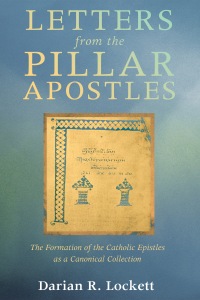2017.07.15 | Darian R. Lockett. Letters from the Pillar Apostles: The Formation of the Catholic Epistles as a Canonical Collection. Eugene, OR: Pickwick Publications, 2017. ISBN: 9781620327562.
Reviewed by Kelsie Rodenbiker, Durham University, UK.
In Letters from the Pillar Apostles, Lockett is concerned to establish the early legitimacy of the Catholic Epistles (CE) as a historically and hermeneutically plausible canonical collection and thus an equal New Testament (NT) sub-corpus alongside the fourfold Gospel and Pauline epistles (pp. xvii, xviii). Noting an oft-assumed discontinuity, Lockett states, “[r]ather than emphasizing composition (usually associated with the historical-critical approach) or canonization (associated with subsequent, ecclesial, and theological judgments) at the expense of the other, this project considers both in dialectical relationship” in order to demonstrate “that the process of editing, collecting, and arranging of these seven texts is neither anachronistic to their meaning nor antagonistic to their very composition” (p. xvi). Read the rest of this entry »


